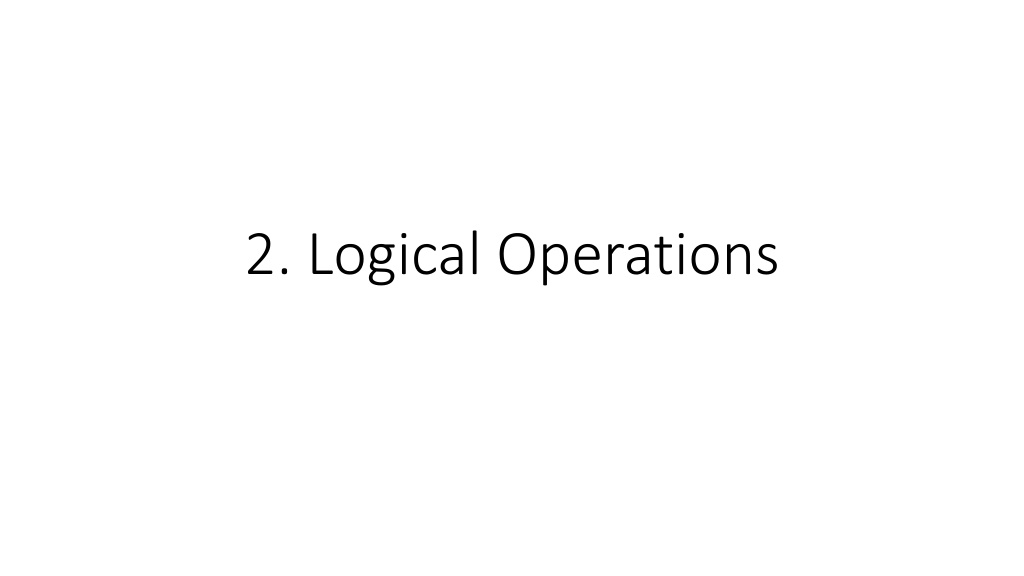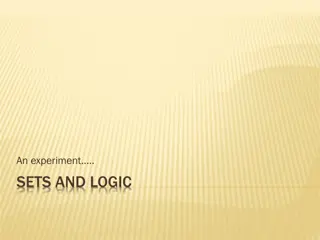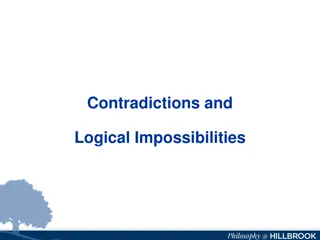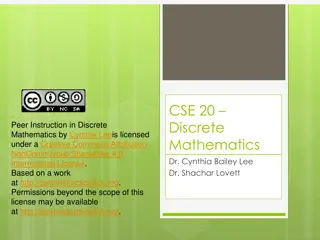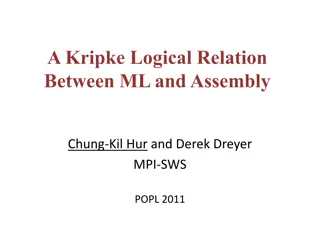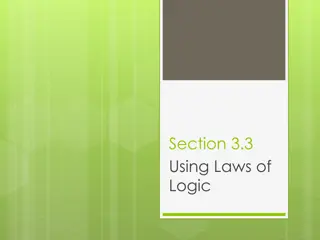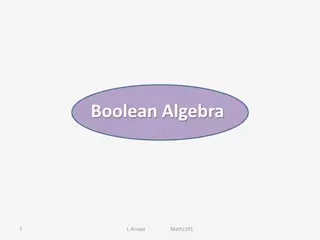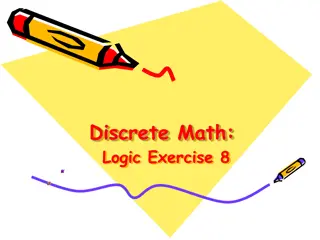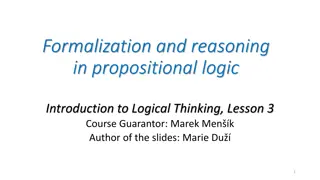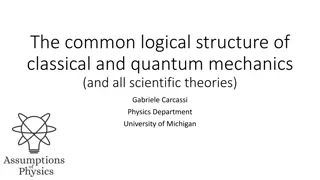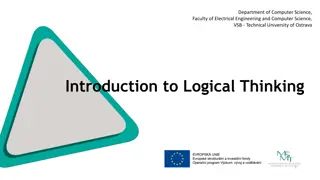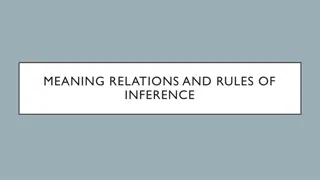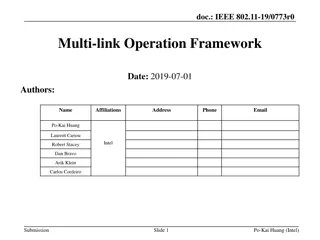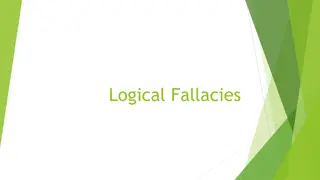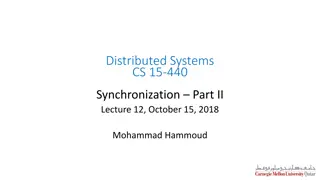Understanding Logical Operations and Their Applications
Logical operators such as AND, OR, NOT, and XOR play a crucial role in programming and control systems. They are used to combine logical expressions and make decisions based on certain conditions. By utilizing truth tables, these operators help in solving problems efficiently. This article explores the use of these operators, their combinations, application in truth tables, and real-world examples in control systems like greenhouse automation.
Download Presentation

Please find below an Image/Link to download the presentation.
The content on the website is provided AS IS for your information and personal use only. It may not be sold, licensed, or shared on other websites without obtaining consent from the author. Download presentation by click this link. If you encounter any issues during the download, it is possible that the publisher has removed the file from their server.
E N D
Presentation Transcript
2.1.1 - Use of AND, OR, NOT and XOR logical operators, combinations of these, and their application in appropriate truth tables to solve problems. Logical operators are used in programming. It is not unusual to find a code such as: IF A = 1 AND B = 1 THEN IF A = 1 OR B = 1 THEN The rules for combining logical expressions are usually written down as tables that list all the possible outcomes. These tables are known as truth tables.
2.1.1 - Use of AND, OR, NOT and XOR logical operators, combinations of these, and their application in appropriate truth tables to solve problems. NOT The NOT logical operator has only one input and one output. The output is the opposite of the input. Input (A) Output (NOT A) 0 1 1 0
2.1.1 - Use of AND, OR, NOT and XOR logical operators, combinations of these, and their application in appropriate truth tables to solve problems. AND The AND logical operator has two inputs and one output. The output is 1 only if A and B are both 1. Input (A) Input (B) Output (A AND B) 0 0 0 0 1 0 1 0 0 1 1 1
2.1.1 - Use of AND, OR, NOT and XOR logical operators, combinations of these, and their application in appropriate truth tables to solve problems. OR The OR logical operator has two inputs and one output. The output is 1 if either A or B is 1. Input (A) Input (B) Output (A OR B) 0 0 0 0 1 1 1 0 1 1 1 1
2.1.1 - Use of AND, OR, NOT and XOR logical operators, combinations of these, and their application in appropriate truth tables to solve problems. XOR The XOR logical operator has two inputs and one output. The output is 1 only if A and B are different. Input (A) Input (B) Output (A XOR B) 0 0 0 0 1 1 1 0 1 1 1 0
Logical operations Logical operations can be used in control systems. For example, a control system that closes the windows on a commercial greenhouse when at least one of the following conditions is true: the wind speed rises above 12 km per hour. it is raining. would use the logical operator OR. On the other hand, a control system that turns on a sprinkler system in a field when both of the following conditions are true: the temperature rises above 25 C it has not rained in the last five days would use the logical operator AND.
2.2.1 - Simplify Boolean expressions using Boolean identities and rules. Notation The logical operators that are going to be used are NOT, AND, OR and XOR. Boolean algebra uses the following notation to represent the input variables and operators: Action Example Boolean expression NOT Not A AND A and B A.B A+B OR A or B XOR A XOR B
2.2.1 - Simplifying Boolean expressions using Boolean identities and rules. Laws of Boolean Algebra Boolean Algebra is a system of mathematics based on logic that has its own set of rules or laws that can be used to simplify Boolean expressions: Annulment Law Identity Law Idempotent Law Complement Law Commutative Law Double Complement Law Distributive Law Absorptive law Associative Law
2.2.1 - Simplifying Boolean expressions using Boolean identities and rules. Annulment Law A.0 = 0 A + 1 = 1 A variable OR 1 is always equal to 1 A variable AND 0 is always equal to 0 A 1 A+1 A 0 A.0 1 1 1 1 0 0 0 1 1 0 0 0
Identity Law A + 0 = A A variable OR 0 is always equal to the variable A.1 = A A variable AND 1 is always equal to the variable A 0 A+0 A 1 A.1 1 0 1 1 1 1 0 0 0 0 1 0
Idempotent Law A + A = A A.A = A A A A+0 A A A.A 1 1 1 1 1 1 0 0 0 0 0 0
Complement Law A. = 0 A + = 1 A A. A A+ 1 0 0 1 0 1 0 1 0 0 1 1
Commutative Law A.B = B.A A + B = B + A A B A.B B.A A B A+B B+A 0 0 0 0 0 0 0 0 0 1 0 0 0 1 1 1 1 0 0 0 1 0 1 1 1 1 1 1 1 1 1 1
A 1 0 1 0 1 0
Distributive Law A.(B + C) = A.B + A.C (OR Distributive law) A B C B+C A.(B+C) A.B A.C A.B + A.C 0 0 0 0 0 0 0 0 0 0 1 1 0 0 0 0 0 1 0 1 0 0 0 0 0 1 1 1 0 0 0 0 1 0 0 0 0 0 0 0 1 0 1 1 1 0 1 1 1 1 0 1 1 1 0 1 1 1 1 1 1 1 1 1
Distributive Law A + (B.C) = (A + B).(A + C) (AND Distributive law) A B C B.C A+(B.C) A+B A+C (A + B).(A + C) 0 0 0 0 0 0 0 0 0 0 1 0 0 0 1 0 0 1 0 0 0 1 0 0 0 1 1 1 1 1 1 1 1 0 0 0 1 1 1 1 1 0 1 1 1 1 1 1 1 1 0 0 1 1 1 1 1 1 1 1 1 1 1 1
Absorptive Law A + (A.B) = A (OR Absorption law) A B A.B A+(A.B) 0 0 0 0 0 1 0 0 1 0 0 1 1 1 1 1
Absorptive Law A.(A + B) = A (AND Absorption law) A B A+B A.(A+B) 0 0 0 0 0 1 1 0 1 0 1 1 1 1 1 1
Associative Law A + (B + C) = (A + B) + C = A + B + C A B C B+C A + (B + C) (A + B) (A + B) + C A+B+C 0 0 0 0 0 0 0 0 0 0 1 1 1 0 1 1 0 1 0 1 1 1 1 1 0 1 1 1 1 1 1 1 1 0 0 0 1 1 1 1 1 0 1 1 1 1 1 1 1 1 0 1 1 1 1 1 1 1 1 0 1 1 1 1
Associative Law A(B.C) = (A.B)C = A.B.C A B C B.C A . (B .C) (A . B) (A . B) . C A.B.C 0 0 0 0 0 0 0 0 0 0 1 0 0 0 0 0 0 1 0 0 0 0 0 0 0 1 1 1 0 0 0 0 1 0 0 0 0 0 0 0 1 0 1 0 0 0 0 0 1 1 0 0 0 1 0 0 1 1 1 1 1 1 1 1
A B A.B 0 0 1 0 0 0 0 1 0 0 0 0 1 0 1 0 1 1 1 1 0 1 0 1
A B A+B 0 0 1 0 0 0 0 1 1 1 1 1 1 0 0 0 1 1 1 1 0 0 1 1
